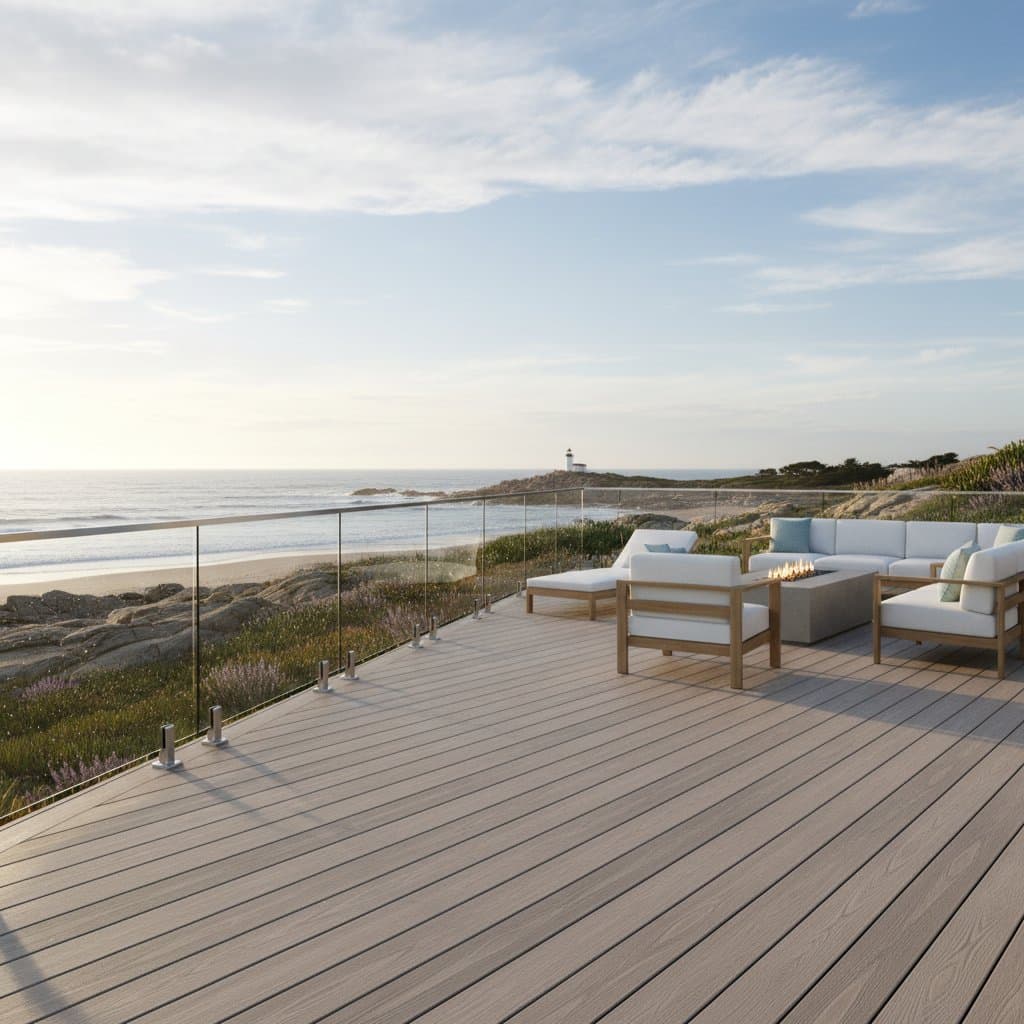Low-Maintenance Decks: Why Composite Tops Wood in Coastal Homes
For homeowners living near the coast, a deck serves as more than an outdoor platform. It provides a daily retreat to enjoy the ocean breeze and the sound of crashing waves. The salt air and humidity that enhance coastal living, however, can damage traditional wood decks. If you have dealt with fading, splintering, or frequent refinishing, you are not alone. Many coastal homeowners select composite decking for its durability and low-maintenance qualities in harsh coastal climates.
This guide details why composite decking surpasses wood, identifies key material features, and outlines planning steps for a deck that maintains its beauty for years with little effort.
Understanding the Challenge of Coastal Decking
How the Coastal Climate Affects Deck Materials
Coastal environments challenge exterior surfaces. Decks near the ocean encounter:
- High humidity and salt exposure that speed up wood rot and corrosion.
- Intense UV rays that cause stains and paints to fade rapidly.
- Frequent moisture cycles that lead to swelling, cracking, and warping.
Even treated lumber degrades in these conditions, resulting in ongoing repair expenses.
Why Maintenance Becomes Overwhelming
Wood decks demand regular care to preserve appearance and strength. Homeowners typically perform:
- Annual power washing and sanding of boards.
- Application of sealants or stains to block water entry.
- Replacement of warped or decayed boards every few seasons.
These activities consume time and generate costs. Composite decking provides an option that minimizes such demands.
What Makes Composite Decking Ideal for Coastal Homes
Composite decking consists of recycled wood fibers blended with plastic resins. This creates a dense, weather-resistant material that resembles wood while avoiding its vulnerabilities.
Built to Resist Moisture and Salt Air
Unlike natural wood, composite boards repel water absorption. This avoids swelling, splitting, and mold development. The plastic components establish a protective layer that blocks salt and moisture penetration. Coastal homeowners benefit from boards that resist rot and screws that avoid corrosion after storms.
Fade and Stain Resistance
Contemporary composite decks feature a polymer cap that withstands fading and staining. Colors stay uniform under prolonged sunlight exposure. Spills from drinks, sunscreen, or ocean spray clean off with soap and water. Sanding or refinishing proves unnecessary.
Low Maintenance, Long Lifespan
A composite deck needs only periodic cleaning with mild soap and water. Painting, sealing, or staining becomes obsolete. Reputable brands endure for decades with limited fading or wear. Although the initial cost per square foot exceeds that of wood, savings in labor and materials over time position composite as a wise choice.
Planning a Low-Maintenance Composite Deck
Choosing the Right Composite Material
Composite products differ in quality and features. Evaluate options based on:
- Capped boards with outer protective layers for enhanced durability.
- Slip-resistant textures suited to humid or wet settings.
- Hidden fastening systems that inhibit rust and yield seamless surfaces.
- Color and grain varieties that match your home's exterior.
Certain brands provide boards with authentic wood-like grains that deliver natural appeal alongside weather resistance.
Proper Installation for Coastal Conditions
Superior materials require expert installation. Engage a licensed contractor experienced in coastal builds. Essential practices include:
- Selection of stainless steel or coated fasteners to resist corrosion.
- Joist spacing that promotes airflow and stability.
- Drainage systems that eliminate pooled water under the deck.
A solid foundation ensures the deck stays level and firm amid heavy rains and humidity.
Smart Design Tips for Coastal Living
Maximize your outdoor area by incorporating:
- Built-in benches that lessen furniture care needs.
- Embedded lighting for secure footing and evening atmosphere.
- Cable railings that maintain ocean vistas and endure corrosion.
Frequently Asked Questions
How long does composite decking last in a coastal climate?
Premium composite decking endures several decades with slight fading or damage. Duration varies by manufacturer, installation precision, and environmental intensity.
Does composite decking get slippery when wet?
Current composites often feature grooved or embossed tops for grip in moist conditions. Verify slip-resistance specifications prior to selection.
Can composite decking handle direct sunlight and heat?
It performs well, though darker hues absorb warmth. Opt for lighter tones to moderate surface temperatures. Composites outperform wood in UV protection.
How do you clean composite decking near the ocean?
Apply mild soap and water, followed by a hose rinse. Steer clear of abrasive chemicals or high-pressure washers that might harm the protective layer.
Is composite decking more expensive than wood?
Upfront expenses surpass those of treated lumber, yet lower maintenance and extended service life yield overall savings.
Can composite decking be cut and installed like wood?
Standard tools allow cutting, drilling, and securing. Adhere to producer directives for optimal outcomes.
Will saltwater corrode the hardware on a composite deck?
Corrosion occurs only with unsuitable fasteners. Choose marine-grade stainless steel or coated options for sustained reliability.
Steps to Build Your Enduring Coastal Deck
Opting for composite over wood extends beyond aesthetics. It represents a strategic choice for decks that demand little ongoing care.
Select robust materials, collaborate with skilled professionals, and prioritize resilient designs. This approach yields an outdoor haven that retains its allure through seasons. Your coastal deck transforms into a dependable, effortless sanctuary for years ahead.

